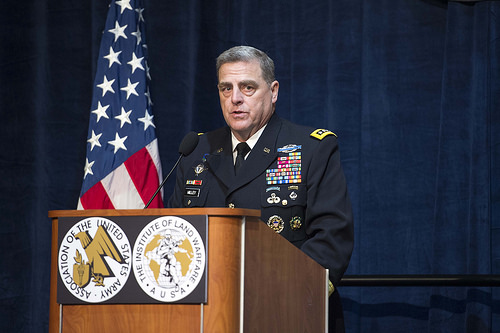 Senior U.S. military leaders have proposed sending more forces into Europe on a rotating basis to build up the American presence and are stepping up training exercises to counter potential Russian interference with troop transfers in the event of a crisis with Moscow….
Senior U.S. military leaders have proposed sending more forces into Europe on a rotating basis to build up the American presence and are stepping up training exercises to counter potential Russian interference with troop transfers in the event of a crisis with Moscow….
Gen. Philip Breedlove, the supreme allied commander of the North Atlantic Treaty Organization, said he would like to see more brigades committed to Europe as rotational forces. Decisions on the proposal, he said, will be made “in the next couple of months.”
Gen. Mark Milley, the chief of staff of the U.S. Army, said the Army is refining its training to ensure the U.S. military is able to face threats posed by Russian forces, learning to counter hybrid war, which blends regular and irregular forces, propaganda and unconventional tactics to sow confusion. He also said he was in favor of sending more troops to deploy—on a temporary basis—to Europe.
Such moves, Gen. Milley said in an interview with The Wall Street Journal, are critical to ensure that no new conflict erupts in Europe.
“Aggression left unanswered is likely to lead to more aggression,” he said.The generals’ comments came over the weekend at the Reagan National Defense Forum here, an annual gathering of U.S. defense and national security leaders.
The proposal for more rotating forces must be formally developed by Pentagon planners and then approved by the Obama administration and funded by Congress. The military will push for the inclusion of funding in a budget request to be sent to Capitol Hill early next year, officials said….
The Army currently has two brigades—of about 3,500 soldiers each—based in Europe. It has assigned one additional brigade in the U.S. to serve as a regionally aligned force that will rotate into and out of Europe. Gen. Milley said he would like to add more brigades to those rotating to Europe, and add attack helicopter units, engineering teams and artillery brigades….
In the event of a conflict, Gen. Breedlove said the U.S. will face a problem both with flying troops from the U.S. to Europe, as well as moving forces and equipment from airports and seaports to front-line conflict zones.
“The Russian navy is not going to stand by and watch us reinforce Europe,” in the event of a confrontation, said Gen. Breedlove. “For two decades we haven’t thought about the fact that we are going to have to fight our way across the Atlantic….”
Throughout the later years of the Cold War, the U.S. military conducted a massive exercise called Reforger, that practiced moving tens of thousands of troops from the U.S. to Europe quickly. While there is no need to revive the exercise on that same scale, a new kind of drill that echoed the old Reforger operation would be helpful, Gen. Milley said.
“Nobody wants to go back to the days of the Cold War,” Gen. Milley said. “We don’t need exercises as big as Reforger anymore. But the concept of Reforger, where you exercise contingency forces … that is exactly what we should be doing.”
Image: Army Chief of Staff, Gen. Mark A. Milley, Oct. 13, 2015 (photo: Sgt. Chuck Burden/US Army)
